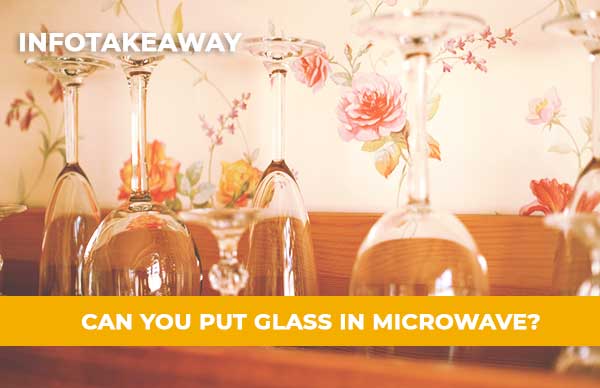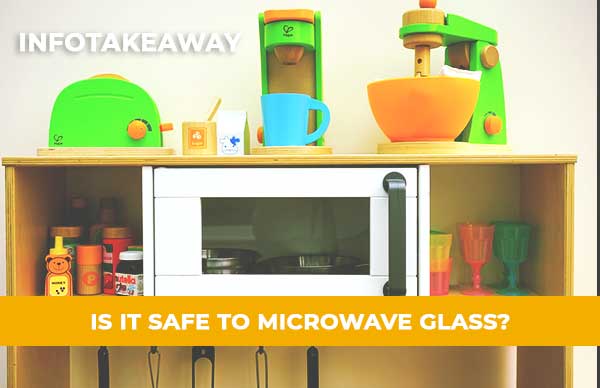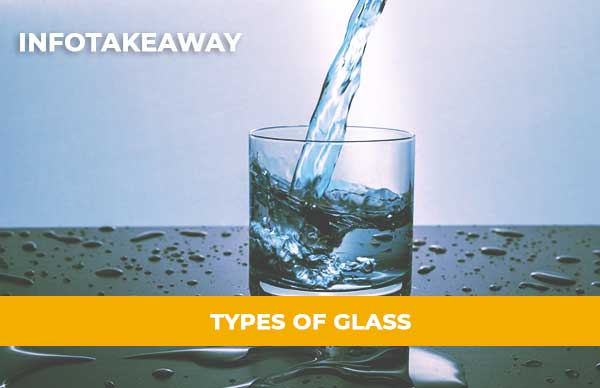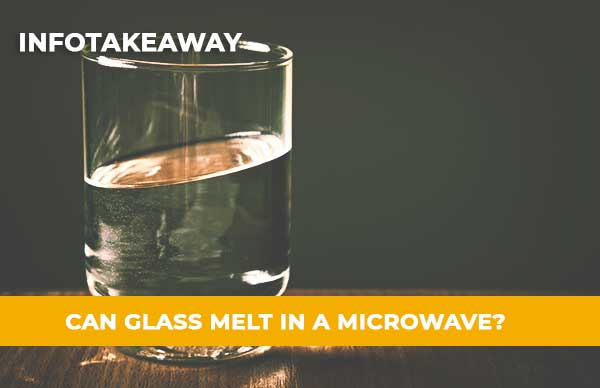You must have wondered whether can you put glass in the microwave and know that It is safe to keep a glass bowl in a microwave. The doubt comes with the material with which class is made. Most utensils made with glass material are microwave safe to put in the microwave.
But if there is a gold or silver rim in the material, then it is highly recommended not to put it on it.
Cold food containers, such as butter tubs or whipped topping bowls, are also avoided because when you heat them at a high temperature, dangerous chemicals are released, which are highly hazardous chemicals in food.
It mixes with the food, and finally, you consume it, causing related harms and symptoms.

Is It Safe To Microwave Glass?

Yes, it is safe to use. It depends upon the duration for which you will microwave your foodstuff in microwave-safe dishes. Keep the power setting of the microwave to low or medium, never high as glass can break at high temperatures if it is cold.
Also, it depends upon the type of glass with which utensils are made up. Keep in mind that plastic containers should also be avoided for usage in microwaves.
Types Of Glasses

There are numerous types of glass that are used for various purposes in construction as well as other purposes.
Basically, glass is a hard substance that is translucent and brittle. It is an amorphous, crystalline, and solid material that displays the properties of both liquid and solids. Different types of glass are used for different purposes.
For example, Soda-Lime Silica Glass is used for the manufacturing of bottles, window panes, dinnerware, bulbs, and jars.
On the other hand, Borosilicate glass is used for the manufacturing of microscopic lenses and slides as well as for household cookware and laboratory glassware such as test tubes, beakers, funnels, etc.
Mostly you will have two types of glass in your kitchen cabin. One is natural glass, and the other is synthetic glass.
Natural glass is obtained from natural resources such as earth crust etc.
But synthetic grass is added with the artificial compounds in order to increase its heat endurance capacity and protect it from cracking.
Synthetic Glass
It is also known as plastic wrap Glass-ceramics and is more heat resistant and microwave-safe glass as compared to natural glass for frozen foods or hot food.
Also, it can be protected from scratches when exposed to heatwaves. If you make a general comparison between methacrylate, polycarbonate, PCV, polyester, and polystyrene glass, with polystyrene, then it is the ideal material for interiors.
Polystyrene feels a very lightweight material but is highly resistant to heat. This is why we use this glass for making glass windows that are highly exposed to the direct sun rays.
If the normal glass is used, then during summer days, it may cause cracking of the window due to high heat.
However, for decorative purposes, it is used for both indoor and outdoor purposes with some precautions.
Can You Put Synthetic Glass In The Microwave
Just like natural glass, it is also safe to put synthetic glass in the microwave. The precautions are also similar in this case.
Avoid putting highly frozen or cold glass directly into the microwave. Rather gives it some time to become normal.
Natural Glass
These glass types or glass vessel is mostly formed on the earth’s crust. The most important natural glasses are tektite and obsidian.
Basaltic deep-sea glass and fractionate glass are also included in this category.
When molten magma at rapid temperature cools down so rapidly, its molecules do not find themselves settling in a regular arrangement.
This results in the formation of natural glass naturally.
Can You Put Natural Glass In The Microwave
The answer to this question depends upon the material with which glass is made. If the glass is made with glass material, it can be placed in freezers, fridges, or even in the microwave.
How much temperature it can bear depends upon the duration for which it is placed and what was in this utensil.
There is no safety risk when you put natural glass into the microwave. It is highly used for microwaves. A thick glass container can easily be put into the microwave, and it will not crack after enduring heat.
It would help if you kept the rule of thermodynamic in your mind. If you will put it for a few minutes in the microwave, then the glass is the best option for warming your food.
However, you need to be mindful of safely handling glasses in the microwave. For example, if the glass was kept in the fridge or freezer, then you should avoid keeping it directly in the microwave.
Because due to cooling, the molecules get shrink and come together. Now when you put it in the microwave, due to heat, the molecule movement becomes violent, and it can cause cracking.
Keeping it outside for a few minutes will normalize the temperature and avoid cracking. Glass is a good conductor of heat, so that it can cause trouble at the last.
Sometimes in extreme cases explosion can occur if you place a highly frozen glass in the microwave.
The abrupt heating of the frozen glass will cause molecules to become too violent that, in the end, an explosion will occur.
On the other hand, it is safe to put slightly cold glass in the microwave. Follow precautions and save yourself from future harm.
Cautions When Using Glass In The Microwave
Following are the potential safety hazard for microwave-safe glassware.
- Cope with the condensation first before exposing it to the heat.
- Please keep it for some time outside so that the temperature becomes normal for cold spots or crystalline structures.
- Put it in the microwave for a few minutes and then check whether the foodstuff is hot or not, and if needed, you can repeat it for a few seconds more. Intense direct heating will put you at risk.
- You can use a good stir for breaking hot and cold pockets in microwave foods. Sometimes when you put foodstuff into the oven, some of the upper layers of food become hot, and the lower layer is still cold. Then stir it for even mixing and put it into the microwave for a few minutes more if needed.
- Always prefer the use of synthetic grass as compared to natural because it is just like plastic and can endure more heat as compared to natural glass.
- Keep in your mind the principle of thermodynamics or extreme heat while dealing with frozen glass.
- Always read the manual for the sake of safety rather than disposing of it. You can also read the microwave manual in which it is mentioned which type of glass is safe to use. Also, the duration is also mentioned in it. If you heat the pot more than the given temperature, then there are chances of cracking and explosion.
- You should avoid the boiling cup of water in the microwave. If you will heat a glass of water slighter more than the boiling temperature, then suddenly, Fragile glasses, glass cups, or glass cookware will come out of the glass. Also, it is not like a stove whereupon boiling yon can immediately turn off the flame.
Read Manuals Of Glass Before Putting Them In The Microwave
One of the best ways for the safety of glass dishes and avoiding future harm is to read the manual.
Most of the time, we become so lazy that we even don’t bother to read the manual and dispose of it into a waste bucket.
It was made for our easiness. So please read the manual rather than disposing of it. Read from the manual what type of glass is used for making your glass utensil.
Also, make sure that how much heat it can endure. You should stick to the duration.
Also, it is recommended to keep it in the microwave for fewer minutes as mentioned in the manual, giving you more security.
You should also read the manual of the microwave. There is a list of utensils that you can safely put onto the microwave.
As an additional precaution avoiding keeping cold glass directly in the oven. Rather, give it some time to normalize the temperature first.
Can Glass Melt In A Microwave

It is highly impossible to believe that the utensil which we use for heating our food can itself melt in extreme temperatures.
Yes, this is true that glass itself melts due to intense heating. If you put it on heating for more than 10 minutes, then at that stage, it does not endure further heat and can itself blast or melt.
Also, if the highly frozen glass is kept in the microwave without making it normalize, there are chances of explosion.
Conclusion – Can You Put Glass In The Microwave
Can you put glass in the microwave? Yes, you can but with safety precautions.
We had a detailed discussion that it is safe to use glass in the microwave or not. It simply depends upon the type of glass with which your utensil or pot is made up.
Also, duration is very critical as a whole. If you heat it more than that of the required temperature, then there are chances of cracking your utensil.
Also, if your pot is frozen due to the refrigerator, then you should avoid keeping it directly in the microwave. The molecules of the glass are condensed at cold temperatures.
And when you heat, molecules will become violent to cause an explosion even. It can also harm you if you are standing right after it.
So always stick to the safety precautions for dealing with these situations also, you should read the manual of the microwave as well as glass describing you a safer side.
Avoiding liquid boiling in the microwave is also needed because slight overheating will cause liquid to come out of the pot.
If you liked this article, also check out “Can dogs eat caramel?“, “Locked keys in trunk“, and “Does CVS have western union?“